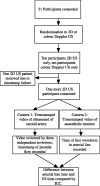The reliability of carotid ultrasound in determining the return of pulsatile flow: A pilot study
- PMID: 30013612
- PMCID: PMC6042301
- DOI: 10.1177/1742271X17753467
The reliability of carotid ultrasound in determining the return of pulsatile flow: A pilot study
Abstract
Manual palpation of pulses is unreliable in detecting pulsatile flow in human participants, complicating the assessment of return of spontaneous circulation after cardiac arrest. Ultrasound may offer an alternative. This study's objective was to investigate whether return of pulsatile flow in humans can be reliably assessed by common carotid artery ultrasound. We conducted a single-blinded randomised study of common carotid artery ultrasound using 20 cardiopulmonary bypass patients to model the return of pulsatile flow. Synchronised time-stamped videos of radial artery invasive blood pressure and 10 two-dimensional or 10 colour Doppler ultrasounds were recorded. Three independent reviewers recorded the timestamp where they considered pulsatile flow was first visible on ultrasound. Ultrasound times were compared to the onset of arterial line pulsatile flow and reliability assessed by intraclass correlation coefficient. The median difference between radial artery and ultrasound flow time (interquartile range (range)) was 24 seconds (5-40 (0-93)) for two-dimensional and 5 seconds (2-17 (-28 to 188)) for colour Doppler. The intraclass correlation coefficient for two-dimensional ultrasound was 0.86 (95%CI 0.63-0.96) and 0.32 (95%CI -0.01 to 0.71) for colour Doppler. The median (interquartile range (range)) mean arterial pressure where ultrasound flow occurred for two-dimensional ultrasound was 62 mmHg (49-74 (33-82)) and 56 mmHg (52-73 (43-83)) for colour Doppler. In our pilot study, two-dimensional ultrasound was reliable in detecting the return of pulsatile flow. Colour Doppler detected pulsatile flow earlier and at lower mean arterial pressure but was not reliable, although a larger study is needed to determine colour Doppler's utility.
Keywords: Anaesthesia; blood flow; clinical speciality; diagnostic imaging; emergency medicine; ultrasound; vascular.
Figures





References
-
- Australian and New Zealand Committee on Resuscitation. Guideline 8: cardiopulmonary resuscitation January 2016, https://www.nzrc.org.nz/assets/Guidelines/BLS/ANZCOR-Guideline-8-CPR-Jan... (2016, accessed 10 April 2016).
-
- Link MS, Berkow LC, Kudenchuk PJ, et al. Part 7: adult advanced cardiovascular life support: 2015 American heart association guidelines update for cardiopulmonary resuscitation and emergency cardiovascular care. Circulation 2015; 132: S444–S464. - PubMed
-
- Ochoa FJ, Ramalle-Gomara E, Carpintero JM, et al. Competence of health professionals to check the carotid pulse. Resuscitation 1998; 37: 173–175. - PubMed
-
- Dick WF, Eberle B, Wisser G, et al. The carotid pulse check revisited: what if there is no pulse? Crit Care Med 2000; 28: N183–N185. - PubMed
-
- Albarran JW, Moule P, Gilchrist M, et al. Comparison of sequential and simultaneous breathing and pulse check by healthcare professionals during simulated scenarios. Resuscitation 2006; 68: 243–249. - PubMed
LinkOut - more resources
Full Text Sources
Other Literature Sources
Medical
